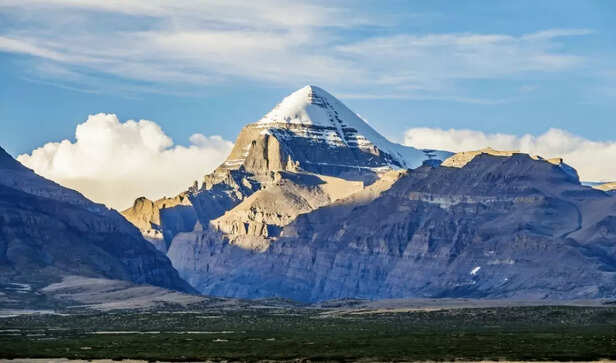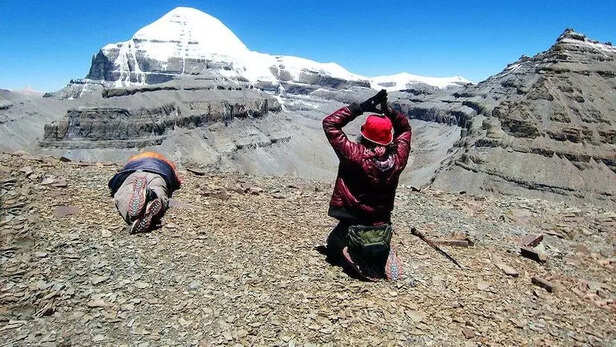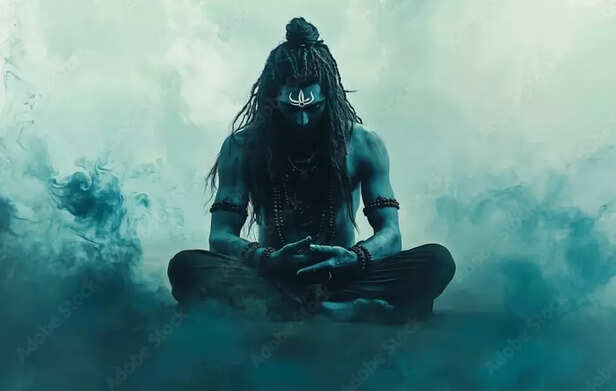Kailash Doesn't Welcome Everyone; its Cold Winds Echo Shiva's Name, Guarding His Divine Realm—Nandi' Warning
Ankit Gupta | Apr 27, 2025, 15:26 IST
Kailash is no haven for all; its merciless winds roar Shiva’s name, fiercely guarding His eternal throne. Mount Kailash, revered as Lord Shiva’s eternal abode, holds profound significance in Hinduism. This sacred mountain symbolizes the center of the universe, the axis of creation, and the ultimate spiritual destination where divine energy radiates. Journey through its mythological roots, cosmic importance, and the deep devotion that makes Kailash a timeless beacon for seekers.
Mount Kailash, located in the remote Tibetan plateau, is one of the most revered and mystically charged peaks in the world. For Hindus, this mountain is more than just a physical landmark; it is the dwelling place of Lord Shiva, the destroyer of illusions and the cosmic force of transformation. To Hindus, Kailash is the pinnacle of sacredness, the ultimate destination of pilgrimage, and the heart of the universe. Its inaccessibility, harsh environment, and pristine natural beauty add to its allure as the abode of the Lord of Lords. Not only is it the spiritual home of Lord Shiva, but it also holds cosmic significance in the Hindu faith, symbolizing the path to liberation, self-realization, and divine union.
The significance of Mount Kailash is not restricted to Hinduism alone. It is also revered in other spiritual traditions such as Buddhism, Jainism, and Bon. However, for Hindus, it is the eternal residence of Shiva, the place where the divine and the mortal realms intersect. In this article, we explore the importance of Mount Kailash for Hindus and why it is considered Shiva’s natural heavenly abode.

Mount Kailash stands tall at an elevation of 6,638 meters (21,778 feet), situated in the southwestern region of Tibet. Its snow-covered peak, which rises above the barren Tibetan landscape, has fascinated and intimidated travelers for centuries. Geographically, the mountain is part of the Kailash Range, which lies at the edge of the Tibetan Plateau. Its distinct, pyramidal shape and isolated location contribute to its aura of mystery and reverence.
From a spiritual perspective, Kailash is seen as the axis of the universe, the central point around which all creation revolves. In Hindu cosmology, it is believed that Kailash is the axis mundi—the sacred center of the world—connecting heaven and earth. The mountain symbolizes the cosmic pillar, a symbol of eternal stability, wisdom, and divine power. The mountain is a direct manifestation of the cosmic order, reflecting the grandeur of Lord Shiva’s eternal presence.
The inaccessibility of Kailash only enhances its divine status. The harsh, freezing winds, snowstorms, and rugged terrain deter all but the most devoted pilgrims. This physical isolation mirrors Shiva’s own nature as a deity who remains detached and aloof from the material world, existing above human concerns and transcending the cycles of life and death. Kailash’s geographical majesty, coupled with its spiritual significance, makes it a truly unique site, both in the physical and metaphysical realms.

The mythology surrounding Mount Kailash is steeped in ancient texts and stories that trace its connection to Lord Shiva. According to Hindu legends, Kailash was the sacred dwelling of Lord Shiva and his consort, Parvati. The mountain became Shiva's divine abode after He chose it as a retreat from the chaos of the world. It is said that the great Shiva, known for His asceticism and renunciation, desired a place of profound solitude and peace. Kailash, with its rugged peaks and serene environment, offered the perfect sanctuary.
One of the most famous myths associated with Kailash is the story of Shiva's marriage to Parvati. It is believed that after many trials, Parvati ascended Kailash and performed severe penance to win Shiva’s love and hand in marriage. The wedding, a symbol of divine union, took place amidst the towering peaks of Kailash, marking the mountain as not only the abode of Lord Shiva but also as the site of divine love and cosmic harmony.
Kailash is also home to the celestial beings and divine creatures that accompany Shiva. Nandi, the sacred bull, is one of Shiva’s most loyal companions and is said to guard Kailash. Nandi represents loyalty, strength, and devotion, and his presence at Kailash underscores the reverence and devotion that this sacred space invokes. Kailash, thus, becomes more than a physical home; it is a divine realm, inhabited by the deities, sages, and cosmic beings who maintain the balance of the universe.

Mount Kailash is not merely a geographical entity but also a deep representation of Lord Shiva’s intrinsic nature. Shiva is often depicted as the lord of destruction, transformation, and transcendence. His abode, Kailash, reflects these attributes in its very form and essence. The mountain’s harsh climate, its isolated location, and its stark beauty embody Shiva’s detachment from the material world and His embrace of asceticism and austerity.
Shiva’s nature is one of ultimate independence and liberation. He does not conform to societal norms or desires; instead, He exists as the embodiment of formlessness, boundlessness, and freedom. Similarly, Kailash’s towering peak, above the clouds and beyond human reach, is a symbol of this unyielding, transcendental nature. It is a place where earthly concerns dissolve and only the infinite presence of Shiva remains.
Moreover, Kailash’s harsh, inhospitable environment serves as a reminder of the profound power and discipline that Shiva represents. Just as the mountain stands firm and unshaken, Shiva too remains immutable and steadfast, unaffected by the turmoil of the material world. Kailash, therefore, is not just a geographical place but a living symbol of Shiva’s eternal, unchanging essence.
The journey to Mount Kailash is considered the ultimate pilgrimage for Hindus. Known as the Kailash Mansarovar Yatra, this sacred trek takes devotees through the rugged terrain of Tibet to reach the foot of the holy mountain. The journey itself is seen as a path of purification, self-discipline, and devotion, requiring great determination and resilience.
Pilgrims who undertake the Kailash Yatra do so with the belief that reaching Kailash will bring them spiritual liberation (moksha) and the blessings of Lord Shiva. The trek is not easy, and the physical hardship involved is viewed as a form of penance that helps purify the body and mind. Many pilgrims complete a ritual circumambulation (parikrama) of Mount Kailash, walking around its base to honor the mountain and seek Shiva’s divine grace.
The Yatra is accompanied by various rituals and spiritual practices. Pilgrims often carry sacred offerings, chant mantras, and perform prayers along the way. The sacred Mansarovar Lake, located near Kailash, is another key site of worship during the journey. It is believed that bathing in the holy waters of the lake washes away the sins of the devotee, further deepening the spiritual significance of the pilgrimage.
Kailash, as the abode of Lord Shiva, becomes the ultimate destination for those seeking liberation. The mountain is regarded as the key to unlock the cycle of birth, death, and rebirth. Those who complete the pilgrimage with pure devotion and unwavering faith are believed to attain moksha and escape the endless cycle of reincarnation.
Mount Kailash in the Context of
Hindu scriptures, such as the Vedas, Puranas, and the Shiva Purana, often mention Mount Kailash as the sacred seat of Lord Shiva. The Rig Veda, one of the oldest texts in Hinduism, alludes to the sacredness of the mountain in various hymns that praise the natural world and its connection to divine forces. The Shiva Purana, in particular, details the legends surrounding Kailash and describes it as the eternal abode of Lord Shiva and Parvati.
The significance of Kailash is also found in the Ramayana, where it is mentioned as the place where Lord Shiva resides in his ascetic form. Additionally, the Mahabharata speaks of Kailash as a destination for great sages and saints, reinforcing its association with spiritual enlightenment.
The symbolism of Kailash in these scriptures underscores its importance not only as a physical location but also as a symbol of spiritual purity and divine order. The mountain represents the highest level of spiritual attainment, where the devotee transcends the limitations of the material world and attains union with the divine.

Beyond its external significance, Mount Kailash serves as a powerful symbol of the inner journey towards self-realization. The mountain’s harsh, remote nature is a metaphor for the challenges one must overcome to reach the ultimate state of spiritual enlightenment. Kailash represents the difficult but rewarding path to enlightenment, where the seeker must shed attachments, transcend the ego, and purify the mind.
In this sense, Kailash is not just a physical location but an inner realm that every devotee must visit in their quest for self-knowledge and union with the divine. The pilgrim’s journey to Kailash reflects the spiritual journey within, where the obstacles and hardships encountered along the way symbolize the inner struggles one must face in order to attain peace, liberation, and divine grace.
Lord Shiva’s abode, Kailash, represents the state of inner stillness and detachment that every seeker strives for. Just as Shiva resides at the peak of Kailash, untouched by the external world, the soul’s highest state of being is one of inner tranquility and connection with the divine.
Lord Shiva’s eternal presence at Mount Kailash is a central aspect of its significance. Kailash is not merely a temporary resting place but an embodiment of Shiva’s timeless and infinite nature. The mountain represents Shiva’s transcendence over time, space, and worldly concerns. He is not bound by the limitations of existence; rather, He exists as the timeless, ever-present force that governs the cosmos.
Kailash serves as a bridge between the material and spiritual realms, a place where the soul can connect with the divine. It is said that Shiva’s presence is felt at every moment, and those who approach Kailash with pure devotion are blessed with His divine grace. The eternal nature of Shiva is reflected in the unchanging, unyielding presence of Kailash, which stands as a monument to the timeless power of the Lord.
Mount Kailash is not only the home of Shiva but also a key point of connection between the earthly and cosmic realms. It is believed that Kailash is aligned with the stars and planets, forming a cosmic axis that connects the physical world with the divine. The alignment of Kailash with the cosmos makes it a point of cosmic energy, channeling the divine forces that govern creation, preservation, and destruction.
In this cosmic context, Kailash is seen as the heart of the universe, with Shiva at its center. The energy emanating from Kailash is believed to be the source of all creation and destruction, reflecting the cyclical nature of the universe. As the cosmic center, Kailash represents the balance of forces that sustain the order of the universe, and it is said to be the place where all spiritual and material energies converge.
Mount Kailash, in its geographical, spiritual, and symbolic significance, remains one of the most important sacred sites in Hinduism. It is not merely a physical mountain but a living symbol of Lord Shiva’s eternal, unchanging nature. As Shiva’s natural heavenly home, Kailash represents the highest level of spiritual attainment, the ultimate path to liberation, and the intersection of the divine and the mortal realms.
For Hindus, the pilgrimage to Kailash is a journey of self-purification, devotion, and spiritual realization. It is a reminder that the ultimate goal of life is to transcend the material world, unite with the divine, and attain eternal peace. Mount Kailash, in all its majesty and mysticism, continues to stand as a beacon of Shiva’s cosmic power, guiding all who seek His grace on the path to liberation
The significance of Mount Kailash is not restricted to Hinduism alone. It is also revered in other spiritual traditions such as Buddhism, Jainism, and Bon. However, for Hindus, it is the eternal residence of Shiva, the place where the divine and the mortal realms intersect. In this article, we explore the importance of Mount Kailash for Hindus and why it is considered Shiva’s natural heavenly abode.
The Spiritual and Geographical Majesty of Mount Kailash

Cherish the Presence
Mount Kailash stands tall at an elevation of 6,638 meters (21,778 feet), situated in the southwestern region of Tibet. Its snow-covered peak, which rises above the barren Tibetan landscape, has fascinated and intimidated travelers for centuries. Geographically, the mountain is part of the Kailash Range, which lies at the edge of the Tibetan Plateau. Its distinct, pyramidal shape and isolated location contribute to its aura of mystery and reverence.
From a spiritual perspective, Kailash is seen as the axis of the universe, the central point around which all creation revolves. In Hindu cosmology, it is believed that Kailash is the axis mundi—the sacred center of the world—connecting heaven and earth. The mountain symbolizes the cosmic pillar, a symbol of eternal stability, wisdom, and divine power. The mountain is a direct manifestation of the cosmic order, reflecting the grandeur of Lord Shiva’s eternal presence.
The inaccessibility of Kailash only enhances its divine status. The harsh, freezing winds, snowstorms, and rugged terrain deter all but the most devoted pilgrims. This physical isolation mirrors Shiva’s own nature as a deity who remains detached and aloof from the material world, existing above human concerns and transcending the cycles of life and death. Kailash’s geographical majesty, coupled with its spiritual significance, makes it a truly unique site, both in the physical and metaphysical realms.

Sacred Land
The mythology surrounding Mount Kailash is steeped in ancient texts and stories that trace its connection to Lord Shiva. According to Hindu legends, Kailash was the sacred dwelling of Lord Shiva and his consort, Parvati. The mountain became Shiva's divine abode after He chose it as a retreat from the chaos of the world. It is said that the great Shiva, known for His asceticism and renunciation, desired a place of profound solitude and peace. Kailash, with its rugged peaks and serene environment, offered the perfect sanctuary.
One of the most famous myths associated with Kailash is the story of Shiva's marriage to Parvati. It is believed that after many trials, Parvati ascended Kailash and performed severe penance to win Shiva’s love and hand in marriage. The wedding, a symbol of divine union, took place amidst the towering peaks of Kailash, marking the mountain as not only the abode of Lord Shiva but also as the site of divine love and cosmic harmony.
Kailash is also home to the celestial beings and divine creatures that accompany Shiva. Nandi, the sacred bull, is one of Shiva’s most loyal companions and is said to guard Kailash. Nandi represents loyalty, strength, and devotion, and his presence at Kailash underscores the reverence and devotion that this sacred space invokes. Kailash, thus, becomes more than a physical home; it is a divine realm, inhabited by the deities, sages, and cosmic beings who maintain the balance of the universe.
Kailash as a Symbol of Shiva’s Nature

Shiva's Eternal Abode
Mount Kailash is not merely a geographical entity but also a deep representation of Lord Shiva’s intrinsic nature. Shiva is often depicted as the lord of destruction, transformation, and transcendence. His abode, Kailash, reflects these attributes in its very form and essence. The mountain’s harsh climate, its isolated location, and its stark beauty embody Shiva’s detachment from the material world and His embrace of asceticism and austerity.
Shiva’s nature is one of ultimate independence and liberation. He does not conform to societal norms or desires; instead, He exists as the embodiment of formlessness, boundlessness, and freedom. Similarly, Kailash’s towering peak, above the clouds and beyond human reach, is a symbol of this unyielding, transcendental nature. It is a place where earthly concerns dissolve and only the infinite presence of Shiva remains.
Moreover, Kailash’s harsh, inhospitable environment serves as a reminder of the profound power and discipline that Shiva represents. Just as the mountain stands firm and unshaken, Shiva too remains immutable and steadfast, unaffected by the turmoil of the material world. Kailash, therefore, is not just a geographical place but a living symbol of Shiva’s eternal, unchanging essence.
The journey to Mount Kailash is considered the ultimate pilgrimage for Hindus. Known as the Kailash Mansarovar Yatra, this sacred trek takes devotees through the rugged terrain of Tibet to reach the foot of the holy mountain. The journey itself is seen as a path of purification, self-discipline, and devotion, requiring great determination and resilience.
Pilgrims who undertake the Kailash Yatra do so with the belief that reaching Kailash will bring them spiritual liberation (moksha) and the blessings of Lord Shiva. The trek is not easy, and the physical hardship involved is viewed as a form of penance that helps purify the body and mind. Many pilgrims complete a ritual circumambulation (parikrama) of Mount Kailash, walking around its base to honor the mountain and seek Shiva’s divine grace.
The Yatra is accompanied by various rituals and spiritual practices. Pilgrims often carry sacred offerings, chant mantras, and perform prayers along the way. The sacred Mansarovar Lake, located near Kailash, is another key site of worship during the journey. It is believed that bathing in the holy waters of the lake washes away the sins of the devotee, further deepening the spiritual significance of the pilgrimage.
Kailash, as the abode of Lord Shiva, becomes the ultimate destination for those seeking liberation. The mountain is regarded as the key to unlock the cycle of birth, death, and rebirth. Those who complete the pilgrimage with pure devotion and unwavering faith are believed to attain moksha and escape the endless cycle of reincarnation.
Mount Kailash in the Context of Hindu Scriptures
The significance of Kailash is also found in the Ramayana, where it is mentioned as the place where Lord Shiva resides in his ascetic form. Additionally, the Mahabharata speaks of Kailash as a destination for great sages and saints, reinforcing its association with spiritual enlightenment.
The symbolism of Kailash in these scriptures underscores its importance not only as a physical location but also as a symbol of spiritual purity and divine order. The mountain represents the highest level of spiritual attainment, where the devotee transcends the limitations of the material world and attains union with the divine.
Mount Kailash and Its Connection to the Inner Self

Awakened one
Beyond its external significance, Mount Kailash serves as a powerful symbol of the inner journey towards self-realization. The mountain’s harsh, remote nature is a metaphor for the challenges one must overcome to reach the ultimate state of spiritual enlightenment. Kailash represents the difficult but rewarding path to enlightenment, where the seeker must shed attachments, transcend the ego, and purify the mind.
In this sense, Kailash is not just a physical location but an inner realm that every devotee must visit in their quest for self-knowledge and union with the divine. The pilgrim’s journey to Kailash reflects the spiritual journey within, where the obstacles and hardships encountered along the way symbolize the inner struggles one must face in order to attain peace, liberation, and divine grace.
Lord Shiva’s abode, Kailash, represents the state of inner stillness and detachment that every seeker strives for. Just as Shiva resides at the peak of Kailash, untouched by the external world, the soul’s highest state of being is one of inner tranquility and connection with the divine.
Shiva’s Eternal Presence at Kailash
Kailash serves as a bridge between the material and spiritual realms, a place where the soul can connect with the divine. It is said that Shiva’s presence is felt at every moment, and those who approach Kailash with pure devotion are blessed with His divine grace. The eternal nature of Shiva is reflected in the unchanging, unyielding presence of Kailash, which stands as a monument to the timeless power of the Lord.
The Cosmic Importance of Kailash and Its Connection to the Universe
In this cosmic context, Kailash is seen as the heart of the universe, with Shiva at its center. The energy emanating from Kailash is believed to be the source of all creation and destruction, reflecting the cyclical nature of the universe. As the cosmic center, Kailash represents the balance of forces that sustain the order of the universe, and it is said to be the place where all spiritual and material energies converge.
The Eternal Abode of Shiva
For Hindus, the pilgrimage to Kailash is a journey of self-purification, devotion, and spiritual realization. It is a reminder that the ultimate goal of life is to transcend the material world, unite with the divine, and attain eternal peace. Mount Kailash, in all its majesty and mysticism, continues to stand as a beacon of Shiva’s cosmic power, guiding all who seek His grace on the path to liberation
